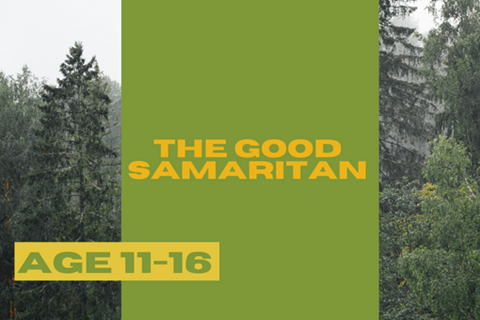
Subscribers only: Download as a PDF here.
BIBLE PASSAGE: Luke 10:25-37
BACKGROUND: This parable comes in the context of a question, and it’s a big one: “What must I do to inherit eternal life?” The man who asked it was trying to catch Jesus out, but he only managed to catch himself.
However, it’s a valid question and one that might provoke some discussion in your group. What’s your own response to this?
Somewhere during this session it would be good to share the background on Samaritans and Jews. They were not such good neighbours!
GATHERING TIME
Ask the group how their week has gone and if anyone has been a hero for them. Has anyone given them any help or encouragement? If
so, how did that help them and make them feel? (Be ready to give your own example if no one offers.) Say that today you are going to be looking at what Jesus said about helping others.
INTRO ACTIVITY
You will need: two different lists of emotions such as joy, fear and anger Split the young people into two teams and give each team a list of emotions.
Challenge them to create freeze frames of the different emotions. Give them a couple of minutes to create their tableaux and then invite them to show their freeze frames to the other team. The other team should try to guess the emotions, and the team that guesses the most correctly wins.
BIBLE EXPLORATION
You will need: Bibles; volunteers to perform the script below (you might want to get them to practise it before the session)
Read Luke 10:25-37 to the group, then invite your actors up to the front to present this drama. Ask people to act out the action
as it is described (this doesn’t need to be rehearsed beforehand):
Commentator 1: Here we are on the Jericho road.
Commentator 2: The weather is hot, hot, hot, and look at what the traveller has got!
C1: Our traveller is sporting a big bag of money.
C2: Which is spotted by a team of armed robbers.
C1: You can see them waving their arms. They act this out.
C2: And it looks like they intend to do him some harm.
C1: Just watch this tactical move as they surround their opponent.
C2: It’s not a fair fight. The gloves are off, and I think we’d better watch this action in slow motion. This is acted out slowly and overly dramatically.
C1: A biff on the head. C2: A bash on the jaw. C1: Bish, bash, bosh!
C2: How much more of this cosh? The person being attacked falls to the floor.
C1: The robbers have won the fight!
C2: Now they’re escaping in broad daylight. The robbers escape with the bag.
C1: Can anyone save the day?
C2: Now the main player is in injury time.
C1: Look down the road. Can this respectable citizen be the one?
Priest: Walks over and takes a good look, then shakes their head and walks on. I have a different goal in my life; one that doesn’t cause me any struggle or strife. Sorry!
C2: Perhaps this new player in the game of life…
C1: Will end the suffering and endless strife. Along comes a Levite who sees the injured person and puts his or her hands together.
C2: It’s good to say a prayer.
C1: But you’ve got to show that you care. The Levite walks on.
C2: Now here comes someone from the other side.
C1: The Samaritans are like a different team. Enter the Samaritan, who stops to help.
C2: But this one is on side.
C1: This Samaritan is acting like a dream. The Samaritan helps the man up.
C2: What a goal in life! C1: To care for everyone! C2: And to neglect no one.
CHATTING TOGETHER
Discuss the story using these questions:
- Why do you think people didn’t stop to help?
- What do you think the people listening to the story thought?
- Why did Jesus tell this story?
CREATIVE RESPONSE
You will need: a coin; two sheets of paper; marker pens
In the story Jesus told, the Samaritan took the man to an inn and paid for him to stay there. Show the young people a coin and the fact that it has two sides. Explain that you are going to look at two sides of being a good Samaritan.
Hand out some large sheets of plain paper and pens, and ask the group to draw two circles. On one circle ask the group to think about the cost of helping someone, for example money, time and reputation. On the other ask them to think about how they might need help from someone else. Sometimes asking for help, showing vulnerability and making people aware of our needs might also cost us. Once everyone has had a chance to write some thoughts down, review what has been recorded inside the two circles.
Allow some time and space for people to reflect and think about those in society, those at their school, those in their street and those within their close circle of family and friends who need help. How can they make a practical difference?
PRAYER
You will need: circles from ‘Creative response’; a marker pen
Ask the group to place the two circles next to each other and draw a third circle that joins them two together. Explain that God can help us in everything we go through and can help us to help others deal with what they are going through.
Allow some time and space to ask God to be that connecting circle in the different areas of your young people’s lives.
Supporting documents
Click link to download and view these files1004269.pdf
PDF, Size 0.44 mb






































